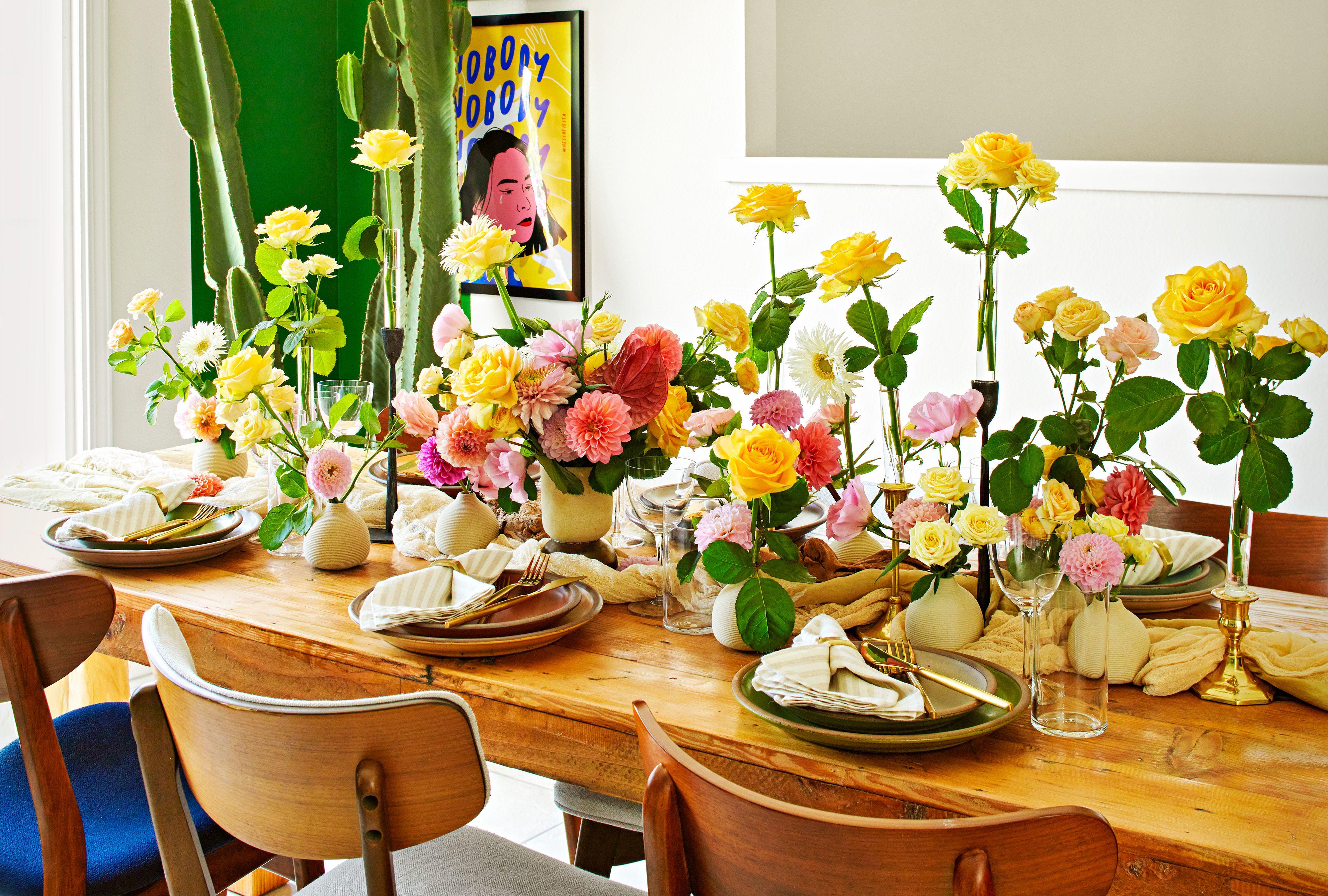Say goodbye to the plastic-looking faux flowers of the past. Today’s artificial blooms have evolved dramatically, beautifully capturing both the authentic look and feel of fresh flowers, but without all the wilting and watering. Here, an experienced event planner shares everything you need to know about how to choose the most realistic faux flowers, as well as the ideal times and places to opt for artificial instead of real.
- Beth Helmstetter is the founder and creative director of her own wedding and event planning firm.
Pros and Cons of Faux Flowers
Beth Helmstetter, founder and creative director of her own wedding and event planning firm, says faux flowers should be considered in context. “I use real flowers from my garden when entertaining, but faux florals are wonderful for spots that don’t get a lot of light or for pieces styled well in advance of guests arriving,” she says. When deciding between real and faux flowers for a specific occasion or spot in your home, consider the following pros and cons first.
Con: Faux Florals Might Cost More Up Front
The cost of faux flowers might give you more sticker shock at the get-go than real blooms, but it’s important to consider long-term cost savings. If you entertain often and prefer a professional-looking floral arrangement in your entryway, you can quickly see a cost savings after going faux.
Con: Low-Quality Versions Can Be Easy to Spot
If you’re considering opting for lower-quality faux flowers, consider the best location and application for their use. Florals that might not look as real can still work in dimly lit areas or in arrangements that will be placed in a tucked-away location where they can’t be as easily examined.
Con: Real Flowers Often Feel More Special
Particularly when you’re giving or receiving flowers, real is often the way to go as the sentimentality of authentic flowers can’t be denied. For anniversaries, birthdays, and any other special moment, faux flowers might not feel as special-occasion worthy.
Pro: Can Make Longer-Lasting Arrangements
Whether you’re arranging flowers well ahead of an event or want an arrangement that doesn’t need swapping out every week, watering every other day, or any other type of maintenance, faux florals might be for you.
Pro: Great for Allergy Sufferers
While their lack of scent might be a con for some, allergy sufferers could find great relief in faux florals that still allow for the beauty of nature, but without the side effects.
Pro: Out-of-Season Florals Are No Problem
If you’re looking for a particular flower variety that is hard to find in your area or blooms that might be out of season, going faux can be a smart alternative.
Related
What to Look For in Faux Flowers
“The best faux flowers are worth it if you plan to use them often. I’d rather have one beautifully made arrangement than a dozen that feel plastic,” says Helmstetter. While faux stems oftentimes come with a higher initial price tag compared to real blooms, the event designer says they can certainly be worth the investment if you use them often and know what to look for.
To find the most realistic-looking ones, the global event designer says tone and texture should be at the top of your list of requirements. “Look for stems that aren’t too shiny, petals with dimension, and opt for florals with slight imperfections in texture and color,” she says. Consider how a flower grown in the wild might look slightly asymmetrical or feature varying shades of green, and try to seek out faux florals that have some of these same traits. “I also love when the stems aren’t too stiff,” Helmstetter says. “A little bend goes a long way.”
Jacob Fox
Where to Use Faux Florals
Helmstetter shares some of her favorite uses for artificial flowers that look anything but faux.
- Bookshelves and mantels. These zones are prime real estate for faux stems as they can provide an alternative to fresh flowers that could more easily wilt due to fireplace heat proximity, lack of light, or simply being forgotten until you finally spot the drooping blooms two weeks later.
- Tucked into real garlands or arrangements. Helmstetter recommends filling out real arrangements and garlands with faux blooms to help add some much-needed color and texture, especially during the winter months when the amount of in-season floral varieties available might be lacking.
- With personal items. “Faux florals are best when they’re part of a larger story—paired with pieces you’ve collected, set in vessels you love, or used to add texture to a tabletop,” says Helmstetter. “The goal is always to create something that feels soulful and welcoming, not perfect.”
- Less-frequently used spaces. Guest bedrooms and bathrooms, hard-to-reach shelves, and even second homes can all be ideal opportunities to opt for a faux floral moment that can make the space feel both inviting and fresh.
- With fresh greenery or herbs. To set your senses ablaze, but with an arrangement with long-lasting power, Helmstetter recommends using real greenery or fresh herbs as a base before filling in with faux blooms for volume. “The secret is in keeping your palette consistent and not overstuffing,” she says. “Less is more.”



